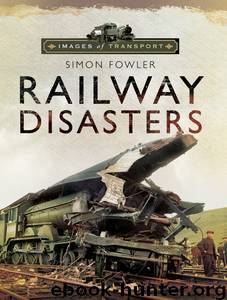Railway Disasters by Simon Fowler

Author:Simon Fowler
Language: eng
Format: epub
Tags: TRANSPORTATION / General
ISBN: 9781473829855
Publisher: Pen & Sword Books
Published: 2013-09-17T16:00:00+00:00
However good the machinery and the systems there is always the possibility of human error. An engine driver nods off, the signalman is distracted, or staff are just generally lax in their duties. As B.K. Cooper wrote in the introduction to O.S. Nock’s Historic Railway Disasters: “Human error remains an imponderable and the reasons for it are often obscure. It has been a hazard for as long as there has been railways, whether caused by misunderstanding, lapses of attention or irresponsible conduct.”
Sloppiness lay behind the accident at Abermule, in mid-Wales on 26 January 1921, which saw fifteen casualties and thirty-seven injuries, when an express train ran into the back of a stopping train at the station. Tom Rolt summed up the accident as “a classic example of the truth that no electrical or mechanical safety devices can altogether eliminate the human element: that in the first instance the safety of the travelling public must always depend upon the efficiency and vigilance of the railway staff.”
Here lax working procedures allowed the safeguards provided by the electric-token system to be circumvented; a driver was handed a token for the wrong section, and proceeded on the mistaken belief the token was correct.
The tablet machines controlling the issuing of tokens or tablets permitting trains to enter single-track sections, were operated by any staff member who happened to be in the vicinity, instead of the stationmaster or the signalman, together with the failure of station staff to notify each other of their actions.
A contributory cause was the failure of anyone to examine the tablet they received by removing it from its pouch and checking it was the correct one. Since the system had worked faultlessly for years, it was being taken for granted. (See page 88)
It is a sobering thought that most railway accidents actually occur to railway staff rather than to the travelling public. In part they result from ignorance on part of both employers and employees. Often the Victorian railway companies refused to introduce basic safety equipment or procedures and made their staff work excessively long hours. In turn employees take short cuts or make silly mistakes. They ignore the rules, don’t see oncoming trains and over-ride equipment.
Alcohol and machinery do not mix. Yet drunkenness was a particular problem on the early railway (as it was elsewhere in society at the time). In November 1838, William Paton of the London and Birmingham Railway wrote a letter describing a collision in which a ballast train was wrecked near Tring. In it he described how Stokes, the driver of one of the engines, managed to save his life by jumping on to the soft embankment. He was apparently “so much intoxicated he did not know the line he was on.”
A less obvious, but more insidious problem, was tiredness. In the early years railway staff were expected to work long hours – twelve hours and more were not uncommon. A contributory factor to the Clayton Tunnel disaster in August 1861 was that Signalman Killick, who controlled
Download
This site does not store any files on its server. We only index and link to content provided by other sites. Please contact the content providers to delete copyright contents if any and email us, we'll remove relevant links or contents immediately.
| Automotive | Engineering |
| Transportation |
Whiskies Galore by Ian Buxton(41529)
Introduction to Aircraft Design (Cambridge Aerospace Series) by John P. Fielding(32888)
Small Unmanned Fixed-wing Aircraft Design by Andrew J. Keane Andras Sobester James P. Scanlan & András Sóbester & James P. Scanlan(32573)
Craft Beer for the Homebrewer by Michael Agnew(17933)
Turbulence by E. J. Noyes(7700)
The Complete Stick Figure Physics Tutorials by Allen Sarah(7137)
Kaplan MCAT General Chemistry Review by Kaplan(6595)
The Thirst by Nesbo Jo(6435)
Bad Blood by John Carreyrou(6274)
Modelling of Convective Heat and Mass Transfer in Rotating Flows by Igor V. Shevchuk(6222)
Learning SQL by Alan Beaulieu(6035)
Weapons of Math Destruction by Cathy O'Neil(5828)
Man-made Catastrophes and Risk Information Concealment by Dmitry Chernov & Didier Sornette(5646)
Digital Minimalism by Cal Newport;(5389)
Life 3.0: Being Human in the Age of Artificial Intelligence by Tegmark Max(5184)
iGen by Jean M. Twenge(5161)
Secrets of Antigravity Propulsion: Tesla, UFOs, and Classified Aerospace Technology by Ph.D. Paul A. Laviolette(4990)
Design of Trajectory Optimization Approach for Space Maneuver Vehicle Skip Entry Problems by Runqi Chai & Al Savvaris & Antonios Tsourdos & Senchun Chai(4839)
Electronic Devices & Circuits by Jacob Millman & Christos C. Halkias(4747)
